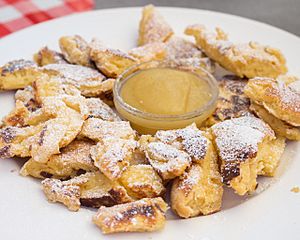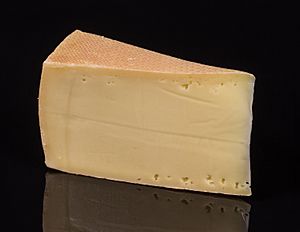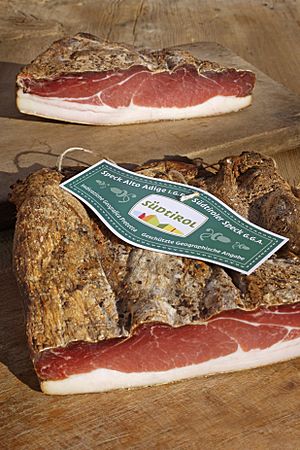Alpine cuisine facts for kids
Alpine cuisine is the name for the traditional food from the Alps mountain region. For hundreds of years, people living in isolated mountain villages and huts have created unique dishes. They used foods that were easy to find and store. These main foods included milk, cheese, grains, desserts, and meat preserved by drying or smoking.
Contents
Delicious Alpine Foods
Cheesy Delights
Milk and cheese have always been super important in Alpine cooking. Farmers in the Alps have raised special cows for milk for a very long time. Even ancient Roman writers like Pliny and Strabo wrote about how much milk Alpine cows produced.
Pliny also mentioned cheeses from the Alps. He said some cheeses from Gaul (an old Roman area) had a strong taste. But don't worry, cheese-making in places like Switzerland has gotten much better! Today, cheeses like Swiss Emmentaler, Allgäuer Bergkäse, and French Tomme de Savoie are famous worldwide. People also make delicious soft and hard cheeses from goat's milk.
Meaty Treats: Bacon and Dried Meats
Because people needed to store meat for the long winter, they developed many special meat products. These have been part of Alpine food for centuries. Many of these, like Tyrolean bacon and South Tyrolean bacon, are now protected. This means they can only be called that if they come from a specific region. Other dried meats, like Kaminwurze sausages, are also very popular.
Breads, Pasta, and Sweet Desserts
Mountain farmers and shepherds work very hard. They need lots of energy, which comes from foods rich in carbohydrates. Besides well-known dishes like Kaiserschmarrn (a shredded pancake) or Bündner barley soup, people in the Alps also grew tough grains. These included rye, barley, and wheat.

Buckwheat was also very important. Sciatt, a buckwheat flatbread, and Pizzoccheri (buckwheat noodles) are special dishes from the Valtellina region. In Slovenia, Žganci is a simple dish made from buckwheat flour. Later, maize (corn) became popular. Today, you'll find it in dishes like polenta or Riebel.
The Alps also have many kinds of baked goods. People often make breads that last a long time, like South Tyrolean Schüttelbrot. In winter, they add dried fruit to breads and cakes. Examples include Kletzenbrot from Austria and South Tyrol, or Swiss Birnbrot. These recipes often came from a need to make expensive bread grains last longer by mixing them with dried fruits.
Here are some other traditional Alpine dishes:
- Buchteln (sweet rolls)
- Germknödel (sweet dumplings)
- Kartoffelpaunzen (potato dumplings)
- Kaspressknödel (cheese dumplings)
- Schlutz- and Schlipfkrapfen (filled pasta)
- Spätzle (small noodles)
Alpine Drinks: Wine and Spirits
The southern parts of the Alps have a good climate for growing grapes. Wine has been made in South Tyrol since before Roman times! Wines from French and Austrian mountain regions are also well-known around the world.
Other special drinks from the Alps include Swiss Chèvre and Austrian Zirbenlikör (pine liqueur). There's also Enzianschnaps, a spirit made from gentian roots. In 2013, UNESCO recognized the knowledge of making Enzianschnaps in the Tyrolean Paznaun valley as an important cultural heritage.
Local Alpine Flavors
The Alps are a huge area with different climates and isolated communities. This means that Alpine food is very different from one region to another. For example, sweet chestnuts are used a lot in French and Italian Alpine cooking. But they are not common in Bavarian or Austrian Alps. On the other hand, Sauerkraut is popular in Bavarian cuisine, but not so much in southern Alpine areas like Tyrol.
People in the Alps work hard to keep their food traditions alive. For example, in Switzerland, an organization called "Culinary Heritage of Switzerland" created an online encyclopedia. It lists over 400 traditional Swiss food products! The Slow Food movement, which started in Italy, also helps protect local food traditions and cultures.




